Noreascon 3 was one of the best Worldcons ever, and the reasons for saying so are in my convention report (reprinted here in five parts a few years ago, opening with Worldcon Wayback Machine: Noreascon Three (1989) Day One). However, the convention still lay months in the future when a controversy brewed up about the committee’s very public and divisive handling of an instance of Hugo bloc voting and a couple of dozen suspicious nominating ballots, all benefitting a specific author couple.
This topic has come up in comments here within the past two days and I thought I would point out there is a great deal of source material available to anyone who really wants to know what happened.
The tip of the iceberg is visible in The Long List of Hugo Awards for 1989 which shows that The Guardsman by P. J. Beese and Todd Cameron Hamilton [Pageant, 1988] was withdrawn as a Best Novel nominee, Todd Cameron Hamilton withdrew as a Best Professional Artist nominee, while authors P. J. Beese and Todd Cameron Hamilton finished sixth for the Campbell Award. No notes explain the withdrawals.
That there were problems became general knowledge for the first time with the release of Noreascon 3’s Hugo nominee announcement in April 1989, containing the committee’s original statement about the status of Hamilton and Beese’s nominations. I’ve been unable to find a copy of the announcement online, so all I can offer on that score is the news account of it in File 770 #79, below.
What the committee initially assumed and how that influenced their interaction with the authors and their public communications was covered again, along with much new material, in Noreascon 3’s second, voluminous press release in June. The text is online here —
- Noreascon Hugo Statement (Part 1 of 2), posted June 16, 1989 in recs.arts.sf-lovers
- Noreascon Hugo Statement (Part 2 of 2), posted June 16, 1989 in recs.arts.sf-lovers
We may not be privy to the Noreascon 3 committee’s internal discussions, but in the second press release they amply explained and justified from their perspective the decisions that they made.
While they were frank about the information they did consider and how they made their decisions, in File 770 I criticized them for deliberately choosing to avoid gathering other useful information that would have influenced those decisions and spared Hamiton and Beese an unjustified public shaming. Copies of the relevant issues have been scanned and put online at Fanac.org in the past year or so, making that writeup easy to find as well.
Now, at least the way it’s working on my computer, the text is small enough to make it hard to read. If you’ll click on the image, it will bring up what at first looks like the same image. Hover your cursor — which now appears as a magnifying glass — over it and click and the page will open to full-size.
- Begin with File 770 #79, page 10, beginning in the lower right-hand column and continuing on page 11.
- Then read File 770 #80, page 2, jump to page 13 and continue through page 21.
The scans from those issues follow the jump. I’ve also included links to the copies at Fanac.org in case the presentation there works better for you.
And in comments I will add one last bit of cryptic information.
FILE 770 ISSUE #79
http://fanac.org/fanzines/File770/File77079-10.html
http://fanac.org/fanzines/File770/File77079-05.html
FILE 770 ISSUE #80
http://fanac.org/fanzines/File770/File77080-02.html
http://fanac.org/fanzines/File770/File77080-13.html
http://fanac.org/fanzines/File770/File77080-14.html
http://fanac.org/fanzines/File770/File77080-15.html
http://fanac.org/fanzines/File770/File77080-16.html
http://fanac.org/fanzines/File770/File77080-17.html
http://fanac.org/fanzines/File770/File77080-18.html
http://fanac.org/fanzines/File770/File77080-19.html
http://fanac.org/fanzines/File770/File77080-20.html
http://fanac.org/fanzines/File770/File77080-21.html
Discover more from File 770
Subscribe to get the latest posts sent to your email.

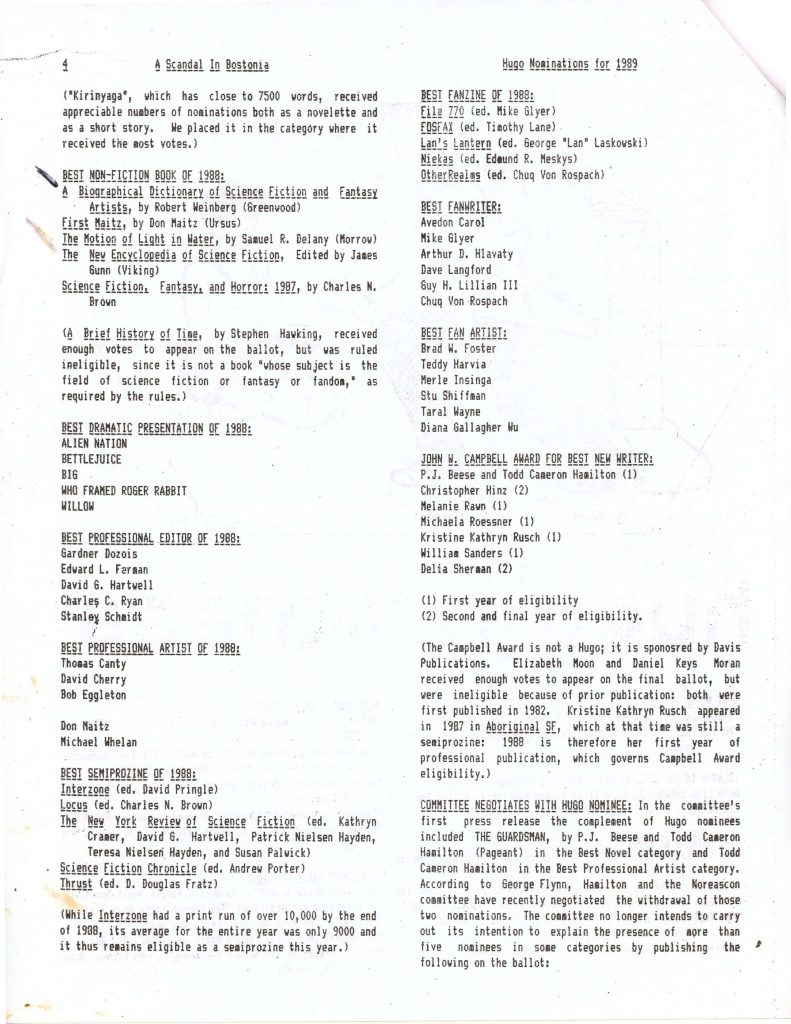
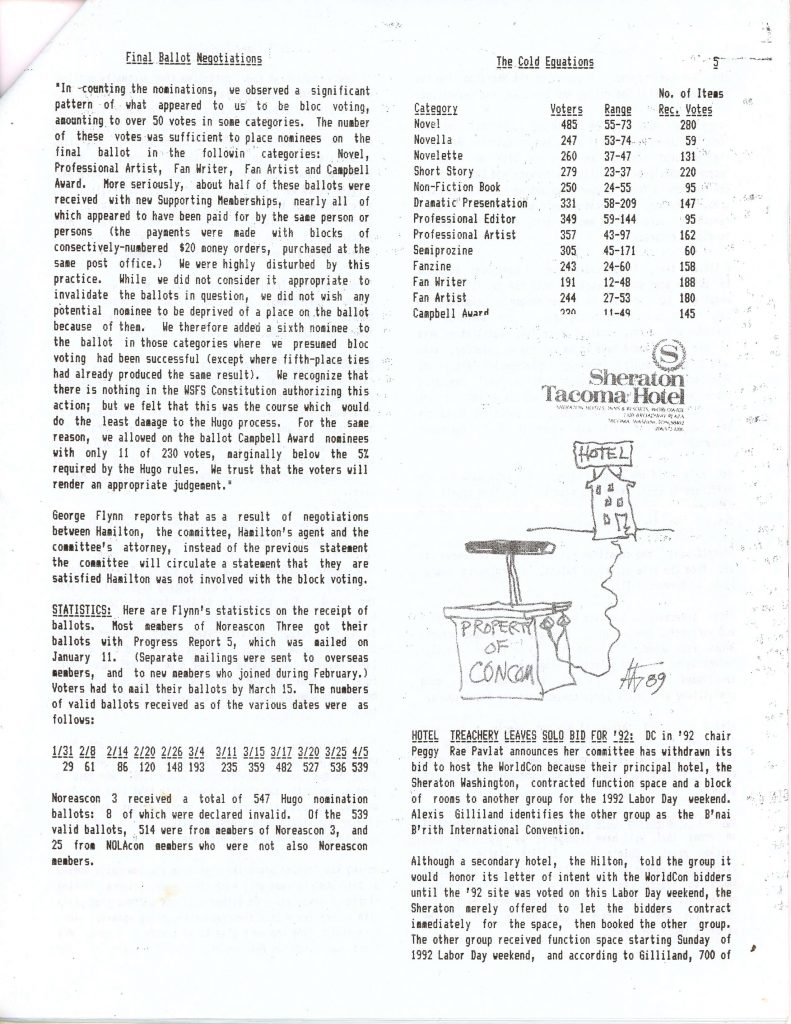
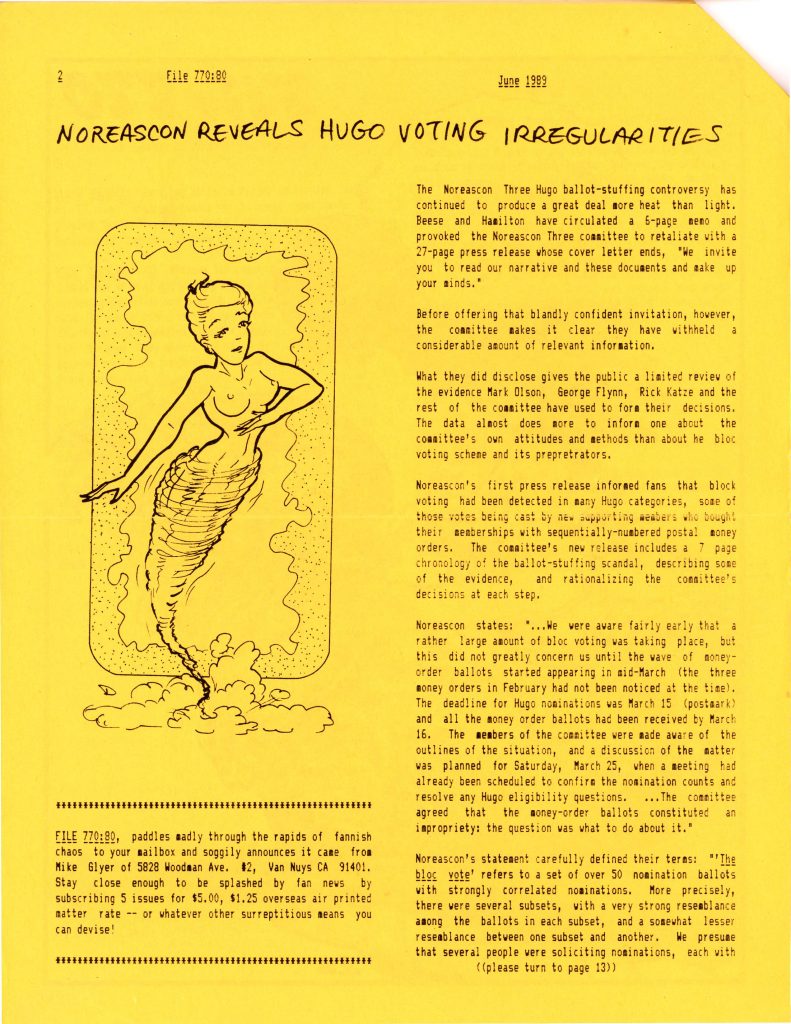

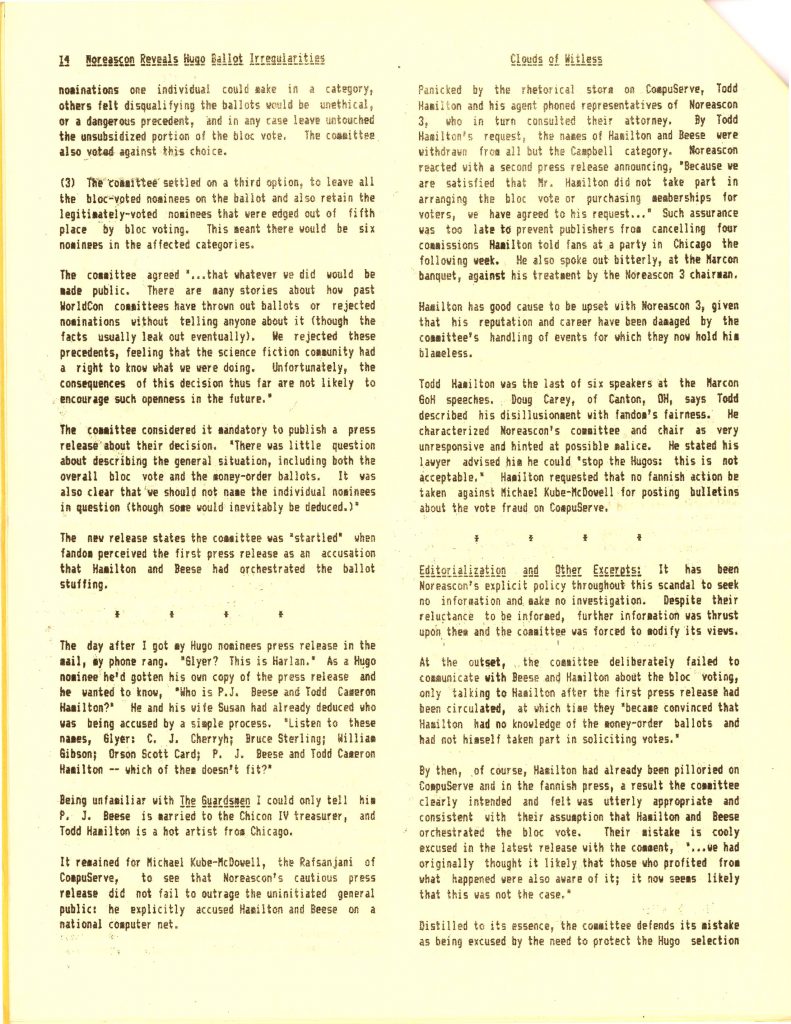



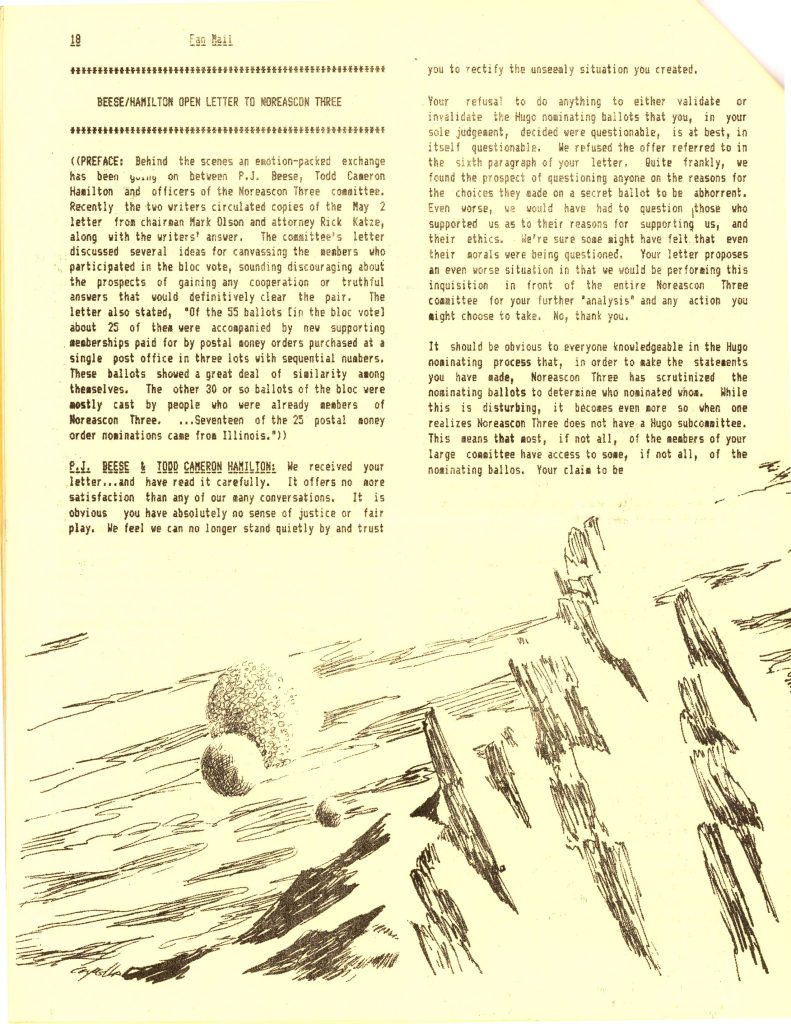

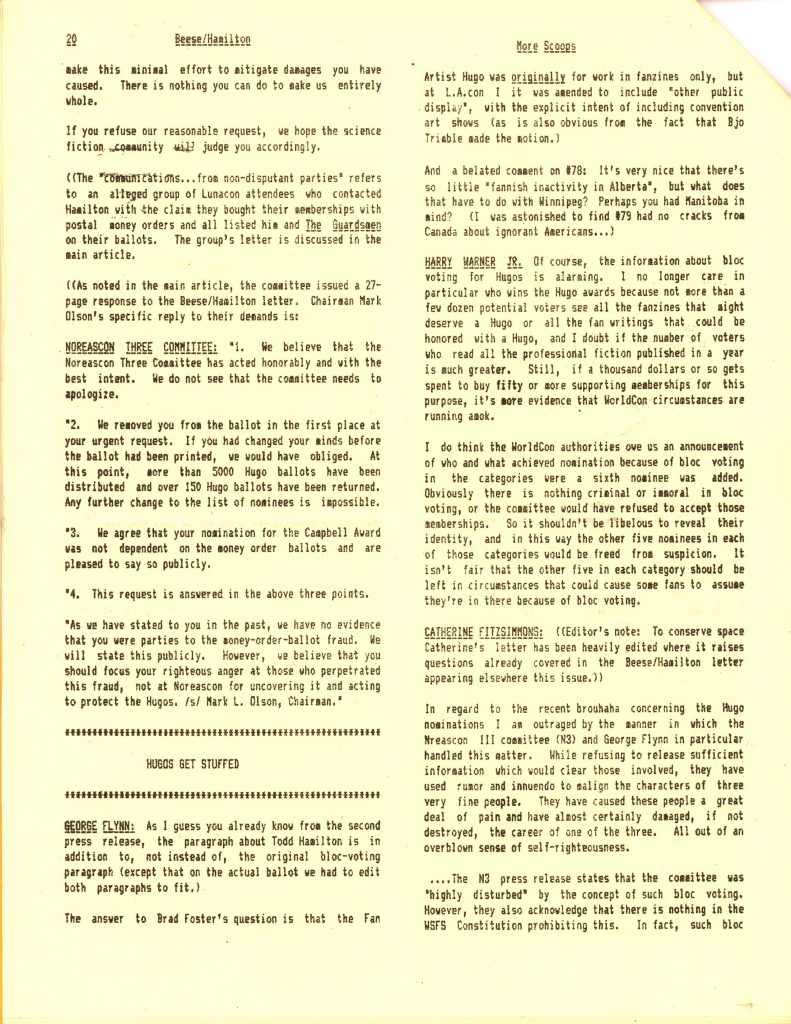
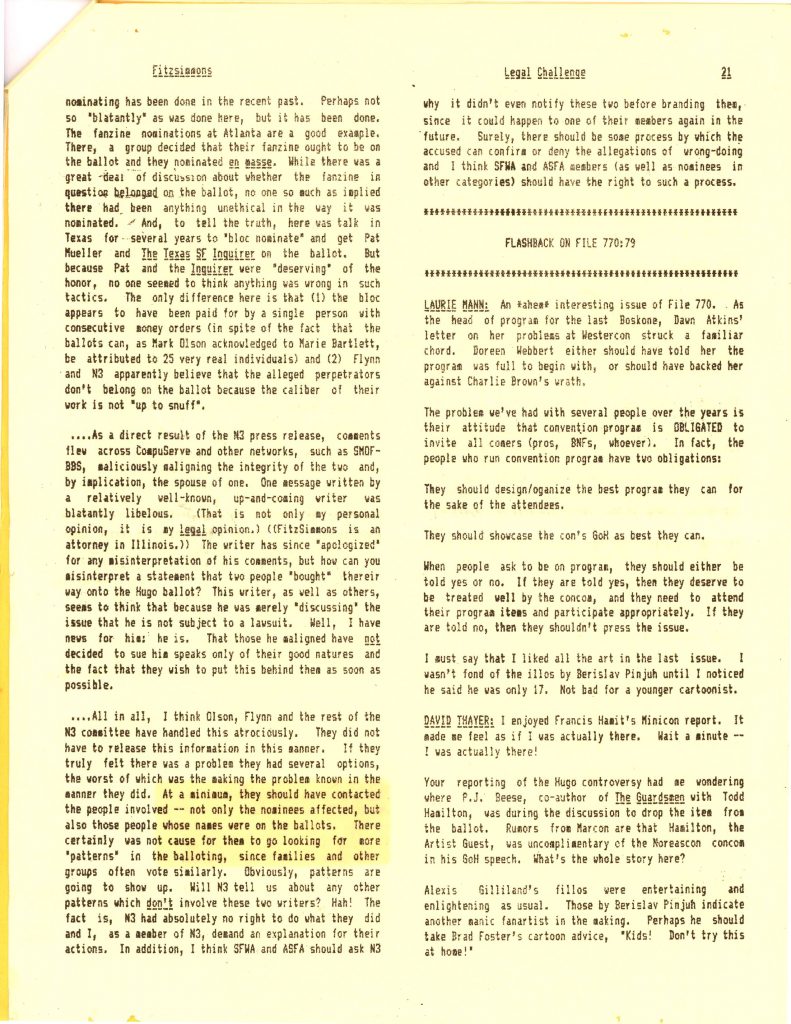
A few months later I was invited to a room party at a convention. Eight or ten of us were there, and in conversation the host told us he had been one of the fans involved in casting the mail order ballots. Obviously there were a lot of questions I’d liked to have asked him, but I didn’t expect him to tell the story for publication, so I let it alone. I tended to believe his claim because it seemed more likely to cause him trouble than anything else.
I have a scan of the letter allegedly sent by the fans who cast the mail order ballots.
Interesting post. I know TCH, but from the early 90s when I started regularly attending cons. I had not known of this issue, but could definitely hear his voice in his letter.
In another odd coincidence, I’m pretty sure that I know at least one of the artists from those scans (The tornado girl and flamingo).
What sticks out to me is the letter from Stackpole. Even if that were the only instance of a ballot being sent without the knowledge of the ostensible sender, it’s a clear case of impersonation and fraud, and it appears to have been swept under the table. Who felt that they could get away with it, and why? That should have been investigated much more rigorously.
Well, at least now I can see why the admins were so reluctant to do anything proactive about slate voting in 2015 and 2016.
Did you ever cover the Leland Sapiro bloc nomination vote controversy during NYCon 3?
I think the relevant newszines might be up on the fanac.org site.
Then there’s the Dick Eney/Mike McInerney accusation noted here:
http://efanzines.com/FocalPoint/FP11.pdf
/tickbox
While there was clearly evidence of nominating votes for a slate in 2015, there was no evidence of a similar block purchase of memberships in Sasquan, such as there was in 1989 for N3.
@John Lorentz Yep. By comparison to 1989, the 2015/2016 problems look almost wholesome. Even though they had a far bigger effect.
I have a question, though. If the people benefiting from the 1989 slating weren’t the authors in question, then why did someone do it? Did anyone ever figure that out?
Of course the authors were the beneficiaries of the bloc voting. Let’s not confuse things needlessly.
There were about 30 regular votes and 25 irregular votes (the ones sent with postal money orders paying for the necessary supporting memberships).
So far as the 30 are concerned, no rules violation was shown, and such a small number (this is just my opinion here) should have been possible from their family, friends, and acquaintances. (This sort of thing happened before, in 1984, as discussed in File 770 #80). Bloc voting was considered contrary to the spirit of how fans were expected to participate (deciding individually what their favorites are), but then as now is not proscribed in the rules.
The 25 irregular votes, from what the public was told by various parties, included one bought in Stackpole’s name that came as a surprise to him, so was probably fraudulent, and 17 which were later claimed by the authors of a cover letter who said they were avid Zelazny fans who admired Hamilton’s artwork for a Roger Zelazny’s Visual Guide to Castle Amber. I’ve never heard that anyone looked into that story, but it represents a way these events could have happened without the authors being involved, and argues against those votes having been fraudulent. I would want to know more before drawing a conclusion about that story.
Mike Glyer: 17 which were later claimed by the authors of a cover letter
One wonders how many of the other 7 were — like Stackpole’s — fraudulent, but the people named on the memberships never found out they had been used in that way. But since Noreascon 3 didn’t contact them and ask, it will never be known.
Given that all 25 money orders were bought at the same Brooklyn post office on 4 different occasions over the course of a month, the purchaser would surely have known who the 25 people were who used them to buy memberships. So it’s interesting that only 17 of them were willing and/or able to sign a letter attesting to the legitimacy of their memberships.
@OGH: what letter was this? The only explanatory letter I recall was (to be polite) massively implausible; it started with a convoy going from ~Chicago to Tarrytown NY (800 miles, says Googlemaps), visiting a couple of Lunacon without registering (not easy, especially at the Art Show — I put up the hangings and remember how crowded it was even without a large group), then decided (en masse) to leave the convention and find a post office to buy money orders — and never come back to the convention, despite having driven such a distance for that purpose. (There were other corroborative details (which failed to add verisimilitude), including a comment about artwork for Zelazny, some of which I think are in the pages you post.) I wonder if there are any primary sources still findable.
The one that the N3 committee transcribed and put in its press release.
It’s all very well to rehash the literary criticism of the letter that was in the press release, but who knows what the committee would have learned had they overcome their unwillingness to talk to anyone who might shed light on what had happened?
This is a psychology I have often seen at work when I was a tax auditor. Before interviewing the taxpayer a colleague would go through their return and get all outraged about things that “obviously” didn’t fit together or make sense. Then they’d meet with the person and hear their explanation — and maybe not even have to make any changes to the return.
It’s apparent why relations between the committee and Hamilton/Beese reached a boiling point, but since the committee had decided against gathering all the available information it should have withheld from making some of its public statements about the nominees.
What public statement did N3 make about the nominees themselves (rather than the process as a whole) that you think the concom should not have made?
Your IRS analogy is suspect. Ballots are things in themselves; a filing is a compression of a year of someone’s life into a few sheets of paper. And does not the filer come in with something plausible, rather than a collection of cliches and improbabilities about things the auditor knows better than the filer? A large part of the N3 concom was at that year’s Lunacon, and knew how hard it would be for a mob to get into the places the letter-writer claimed they got into. This also applies to Heydt’s attempts to provide explanations; Lunacon’s schedule did not fall apart, and was not in the habit of falling apart (although there was a complaint a few years later, about it not having been kept to precisely, that caused the incoming chair to proclaim that the Lunacon staff were not “mindless NESFA robots”). AFAICT, any residual plausibility the arguments might have had is exploded by the Stackpole letter — not to mention the fact that the “local” signatures on the explanation are not on the letter itself (per note 5).
What “gathering all the available information” did you have in mind? IIRC, George Flynn (the actual administrator) thought that any detailed access to the questionable ballots (e.g., to contact their putative submitters) would be a violation of personal privacy and/or ballot secrecy; I am still inclined to that opinion. Another alternative would have been to ask Hamilton and Beese themselves if they had any idea what was going on; this would certainly have been interpreted by some as undue pressure on nominees. And your suggestion is a bit hollow given that you didn’t even ask the person-who-said-they-were-involved whether they’d be willing to talk on the record.